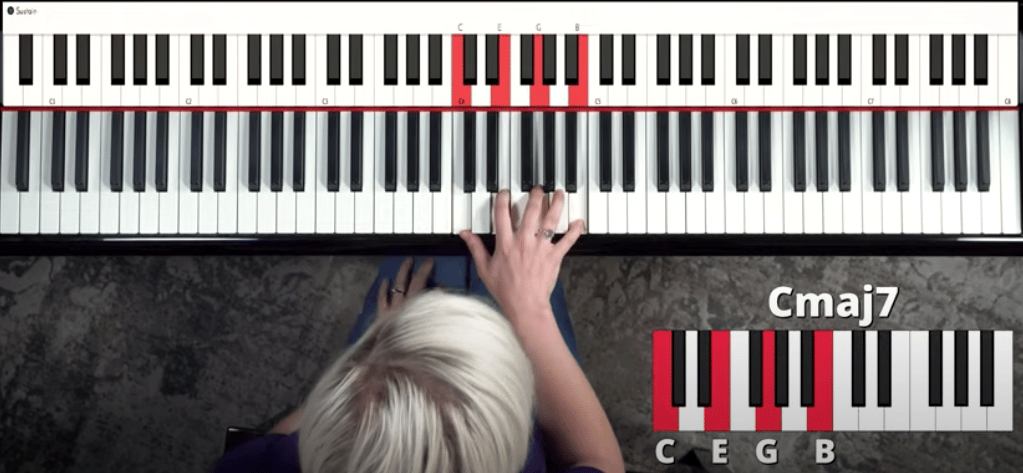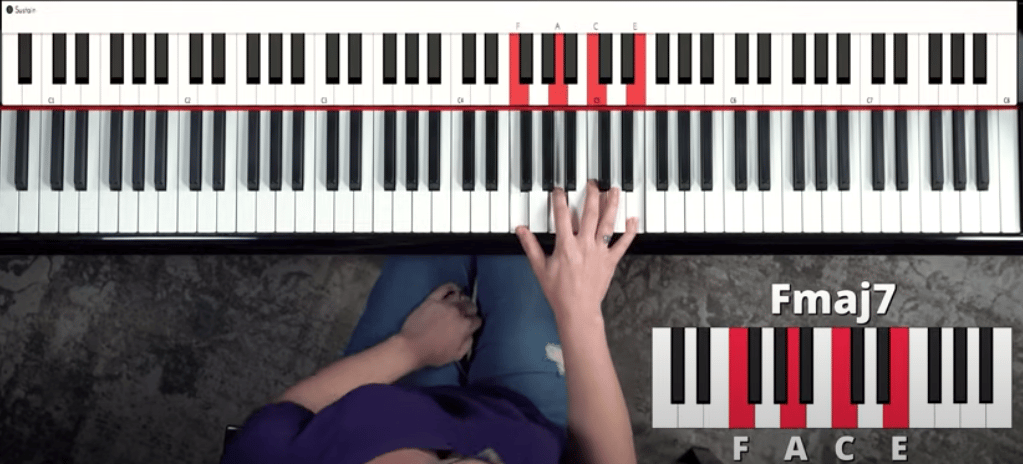This lesson is a 2-for-1. You’ll learn how to play incredible “dreamy” sounds on the piano. AND you’ll also learn a way to practice 7th chord inversions!
That’s right. 7th chords can have inversions too!
Today we’ll only be looking at the Major 7th chord. But you can practice this technique on ANY 7th chord.
The two chords we’ll be using are C Major 7 and F Major 7.
It’s important to get comfortable with these chords and the NOTES that make up each one.
Here’s C Major 7:

As you can see the notes are C-E-G-B. Get familiar with those and remember, it’s only 4 notes!
And here’s F major 7:

Again, only 4 notes (and 2 of them are the same as C Major 7). They’re F-A-C-E.
We’ll start with some left-hand practice. My left-hand is definitely weaker than my right when it comes to 7th chords.
With your left hand, play a C Major 7 broken chord. Just play the notes up and down.
Then with your right-hand, play ANY of the notes that make up that chord. Remember they are C-E-G-B. Play any one, in any order, in any rhythm.
It sounds beautiful! But what it’s also doing is teaching you to identify the notes that make up this chord. That will help you to “see” the chord more clearly in the future (and in all its inversions – more on that soon).
Once you’re comfortable with C Major 7, switch to F Major 7 and do the same thing. Play the broken chord with your left hand and play ANY of the notes that make up the chord with your right hand.
Now we’ll move back to the right-hand and start working on 7th chords in their different inversions.
Just like triads, 7th chords can have inversions. A regular three-note chord has 3 possible shapes. There’s the root position, 1st inversion, and 2nd inversion.
A 7th chord has 4 notes. That means there are 4 possible shapes!
Let’s look at C Major 7. Here it is in root position:

Now, if we take the bottom note (C) and move it to the top we have a chord that looks like this:

It’s still a C Major 7 chord. It still has the notes C-E-G-B, just in a different order (E-G-B-C). This is a C Major 7 in 1st inversion.
Now if we move the bottom note (E) to the top, we end up with this chord shape:

This is a C Major 7 in 2nd inversion. It’s still the same 4 notes, but a new order (G-B-C-E).
There’s one more inversion, and it’s the one I use the most often. To make it, we take the bottom note (G) and move it to the top, giving us this:

This is a C Major 7 in 3rd inversion. I like this one the best because I find it the most comfortable to play with my small hands!
Now, my challenge to you is to do the same exercise for the F Major 7 chord! Figure out each inversion for the chord, remembering that you just take the bottom note and move it to the top.
Now we’ve done the theory, let’s talk about how to practice these inversions in a way that’s fun and musical.
Because just playing inversions is … boring.
Start by playing a broken C Major 7 chord in root position with your right-hand. Just play a simple C note with your left.
When you’re comfortable, try switching from the root position to the 1st inversion. This will require some concentration so take it slow and get it right.
Once you can do that on C, switch to F Major 7 and do the same thing. That chord change creates a really beautiful dreamy sound.
The goal is to be able to play your way through all the different inversions for C Major 7 and F Major 7.
This could take time. Take it slow. Have fun, and enjoy playing dreamy 7th chords on the piano!
Subscribe to The Note for exclusive interviews, fascinating articles, and inspiring lessons delivered straight to your inbox. Unsubscribe at any time.
Lisa Witt has been teaching piano for more than 20 years and in that time has helped hundreds of students learn to play the songs they love. Lisa received classical piano training through the Royal Conservatory of Music, but she has since embraced popular music and playing by ear in order to accompany herself and others. Learn more about Lisa.
/marketing/pianote/promos/april/banner-bg-m.webp)
We use cookies for traffic data and advertising. Cookie Policy »
/marketing/pianote/promos/april/banner-title.webp)